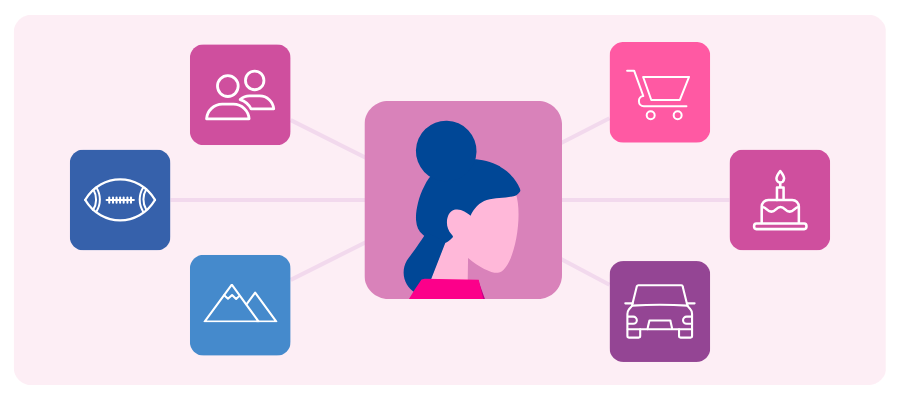At A Glance
Third-party data has moved from a fast-growth, loosely governed environment into one defined by trust, transparency, and compliance. Marketers are now looking for partners with institutional experience and rigorous data standards—not opportunistic providers chasing short-term gains. The brands that win will treat responsible data sourcing as the foundation of their customer strategy.How third-party data has changed and why it matters in 2025
For years, third-party data operated in an expansive, lightly regulated marketplace: fast-moving, high-growth, and filled with players eager to capitalize on digital marketing’s demand for audience insights.
That era is over. Regulatory scrutiny, stricter compliance standards, and rising consumer expectations have already transformed the market. Today, third-party data belongs to partners with proven expertise and built-in compliance. This isn’t a space for opportunistic newcomers; it’s one that rewards long-term commitment and trust.
Even the rapid rise of retail media networks (RMNs) reflects this shift. These platforms are built on long-standing, trusted relationships between brands, retailers, and data partners, utilizing that foundation in new ways to reach audiences responsibly and effectively.
The best providers have already made this transition; those still “shifting” are catching up.
From growth to governance: A market defined by accountability
The third-party data ecosystem has matured. After years of rapid expansion and recalibration, the market has stabilized around a new standard: data quality and regulatory accountability.
Third-party data enriches first-party insights with attributes such as income, gender, and interests that round out the customer view. But when the industry grew unchecked, unreliable providers diluted quality and trust. This resulted in a decline in the overall value and reliability of the third-party data marketplace.

That breakdown led directly to today’s privacy laws, now active across more than 20 U.S. states and numerous countries worldwide. These regulations reflect a permanent consumer expectation: relevance delivered responsibly. Consumers aren’t rejecting personalization; they’re rejecting how it’s been done in the past. They still want relevant, tailored experiences, but they expect brands to deliver them through ethical, transparent data practices.
Does third-party data still matter in a privacy-first era?
Third-party data isn’t disappearing, if anything, it’s become more important. Brands will always need additional insight to deepen customer understanding; first-party data alone only reflects what’s already known.
The industry has entered a mature phase where data quality and compliance are table stakes. The companies leading today built their data infrastructure on rigorous standards, regulatory foresight, and transparent governance.
That same foundation powers the next wave of innovation, including the explosive growth of RMNs. RMNs rely on responsibly sourced third-party data to enrich shopper insights, validate audiences, and extend addressability beyond their own walls. Trusted data partners make that expansion possible, connecting retail environments with broader media ecosystems while maintaining privacy and accuracy.
High-quality, compliant third-party data remains essential because it:
Advancements in AI and machine learning are reshaping how this data is used across the ecosystem. What was once primarily a buy-side tactic is now expanding into the sell-side, where publishers and platforms are using data to curate, package, and activate audiences more intelligently. As AI enhances modeling accuracy and automation, third-party data will play an even greater role in connecting brands and consumers in more meaningful, privacy-conscious ways.
The bottom line: it’s not about having more data; it’s about having better, verified data you can trust.
How can you spot a trustworthy data partner?
The strongest third-party data partners demonstrate accountability through experience, infrastructure, and integrity.
Look for providers that:
Why the future of third-party data depends on accountability
The third-party data industry has already crossed the threshold from expansion to accountability. The companies leading this era have established their credibility through governance and proof. The future belongs to providers that:
- Build with regulatory foresight
- Maintain rigorous quality assurance
- Prioritize partnership over profit
The Wild West days are long gone. The third-party data ecosystem is now defined by stability, transparency, and shared responsibility.
Partner with Experian for data you can trust and results you can prove
When accuracy and accountability define success, you need a partner built on both. Work with the company that’s setting the standard for responsible data-driven marketing and helping brands connect with people in meaningful, measurable ways.
Get started
About the author

Jeremy Meade
VP, Marketing Data Product & Operations, Experian
Jeremy Meade is VP, Marketing Data Product & Operations at Experian Marketing Services. With over 15 years of experience in marketing data, Jeremy has consistently led data product, engineering, and analytics functions. He has also played a pivotal role in spearheading the implementation of policies and procedures to ensure compliance with state privacy regulations at two industry-leading companies.
Third-party data FAQs
Third-party data is information collected by organizations that don’t have a direct relationship with the consumer. It supplements first-party data by adding demographic, behavioral, and interest-based insights.
Privacy regulations are reshaping data practices because consumers expect control over how their information is used. That expectation led directly to today’s privacy laws, now active across more than 20 U.S. states and numerous countries worldwide. These regulations reflect a permanent consumer expectation: relevance delivered responsibly. Consumers aren’t rejecting personalization; they’re rejecting how it’s been done in the past. They still want relevant, tailored experiences, but they expect brands to deliver them through ethical, transparent data practices. Laws like the CCPA and state-level privacy acts enforce this expectation, holding brands and data providers accountable for the ethical use of data.
Yes, brands can still use third-party data safely when sourced responsibly. Partnering with established, compliant providers like Experian ensures both legal protection and data accuracy.
Experian adheres to a set of global data principles designed to ensure ethical practices and consumer protection across all our operations. At Experian, privacy and compliance have long been built in. Every partner and audience goes through Experian’s rigorous review process to meet federal, state, and local consumer privacy laws. Decades of experience have shaped processes that emphasize risk mitigation, transparency, and accountability. Experian’s relationships with demand-side platforms (DSPs), supply-side platforms (SSPs), and even social platforms like Meta, ensures we are aware of any platform-specific initiatives that may impact audience targeting. We’re also active participants in many trade groups to ensure that the industry puts ethical data practices in place to ensure consumers still receive personalized experiences but their data usage and collection is opt-in, transparent and handled with their privacy at the center of the transaction.
Marketers should look for transparency, longevity, and evidence of compliance when looking for a data partner. The best partners can clearly explain how their data is sourced, validated, and maintained. Read Experian’s guide on how you can swipe right on the perfect data partner here.
Latest posts

The digital advertising landscape is undergoing a significant transformation with the gradual deprecation of third-party cookies. This shift necessitates the adoption of new strategies for audience targeting and data management. In our next Ask the Expert segment, we explore this evolution, discussing new strategies for audience targeting and data management in a world without cookies. We’re joined by industry leaders, Gabe Richman, Senior Director of Data Partnerships at The Trade Desk, and Chris Feo, Experian’s SVP of Sales & Partnership who spotlight The Trade Desk’s innovative approach to navigating a cookieless future. Tune in to our Q&A below to learn more about these topics and learn how the collaborative efforts of Experian and The Trade Desk offer a glimpse into the future of advertising. Cookieless IDs are the new face of identity in advertising Traditional tracking and targeting techniques are being replaced by more advanced and privacy-conscious methods. Unified I.D. 2.0 (UID2), led by The Trade Desk, exemplifies this shift, offering a new identifier based on encrypted email addresses or phone numbers. This approach not only caters to the evolving privacy regulations but also places greater control in the hands of consumers. UID2’s design fundamentally differs from cookies since it is rooted in transparency and consumer consent. UID2: A catalyst for industry-wide adoption UID2’s journey reflects a rising industry-wide recognition of its value across the industry. The adoption of UID2 by major publishers, demand-side platforms, and advertisers indicates a shift toward more sustainable and consumer-friendly approaches to identity in advertising. This is particularly evident in areas like connected TV (CTV), where UID2 is rapidly becoming a currency and standard. “The purpose of UID2 is not only to create a better ID for advertisers and publishers to achieve their objectives, but also to benefit the consumers. Unlike cookies, UID2 provides transparency and control to the consumers for the first time.”gabe richman, sr. director, data partnerships, the trade desk How Experian and The Trade Desk work together The partnership between The Trade Desk and Experian goes beyond adapting to the absence of cookies. Our joint efforts highlight a commitment to developing solutions that cater to advertiser’s needs while respecting consumer privacy, a balancing act becoming increasingly crucial in today’s digital ecosystem. The Trade Desk's emphasis on UID2 as a foundational element in the open web, campaign design, and activation is a testament to the potential of new identifiers in enhancing advertising efficacy. Similarly, our ability to utilize these identifiers to deliver detailed audience insights offers advertisers a powerful tool to remain effective in a post-cookie world. Experian’s role in the adoption of UID2 Experian's integration strategies have played a critical role in diversifying the applications of UID2. By partnering with The Trade Desk, we help broaden the reach and effectiveness of UID2 across various advertising channels. In terms of reach – by incorporating a prominent cookieless ID, we further amplify the reach of UID2. The increased adoption of this new ID allows the digital ecosystem the ability to interact using an alternative identifier, thereby broadening the potential audience. In terms of effectiveness – we help advertisers serve relevant ads to the right audiences, ensuring the relevance of the ads and control over their frequency. Targeting with Geo-Indexed audiences The Trade Desk works with Experian to ingest and host our syndicated audiences. This partnership gives The Trade Desk’s clients access to over 2,400 syndicated audiences that span across eight verticals. This includes access to our new Geo-Indexed audiences that allow brands to reach consumers and households based on geographic regions that over-index for a common set of attributes, ultimately offering brands a targeting solution that prioritizes both consumer privacy and accuracy. What a future beyond cookies looks like Looking ahead, the focus in advertising is not solely on replacing cookies but on a broader evolution of the industry. This includes continuing to apply machine learning technologies, like artificial intelligence (AI), to enhance ad personalization and effectiveness. The interplay between creative content, audience insights, and privacy-compliant targeting will become increasingly important as the industry evolves. As cookies become a thing of the past, the initiatives spearheaded by The Trade Desk and Experian will likely set the tone for the next era of digital advertising, and emerging solutions like UID2 are leading the way. Watch the full Q&A Visit our Ask the Expert content hub to watch Gabe and Chris' full conversation about cookieless advertising. In their conversation, Gabe and Chris share more about UID2, consumer transparency, and the importance of consumer data for targeted advertising. Connect with us About our experts Gabe Richman, Sr. Director, Data Partnerships, The Trade Desk Gabe Richman is the Senior Director of Data Partnerships at The Trade Desk where he focuses on global identity strategy and platform partnerships as well as driving UID2 and EUID adoption across the broader ecosystem. Prior to joining The Trade Desk in 2021, Gabe held various roles in AdTech at HealthVerity, Wunderkind and LiveRamp. For the last decade Gabe has taken pride in helping advertisers and platforms alike demystify the complex identity landscape and embrace the change needed to preserve the open internet. Gabe is a graduate of the University of Maryland and resides in Los Angeles. Chris Feo, SVP, Sales & Partnerships, Experian As SVP of Sales & Partnerships, Chris has over a decade of experience across identity, data, and programmatic. Chris joined Experian during the Tapad acquisition in November 2020. He joined Tapad with less than 10 employees and has been part of the executive team through both the Telenor and Experian acquisitions. He’s an active advisor, board member, and investor within the AdTech ecosystem. Outside of work, he’s a die-hard golfer, frequent traveler, and husband to his wife, two dogs, and two goats! Latest posts

Magnite and Experian have formed a strategic integration to enhance cross-device audience targeting in the advertising industry. Magnite, the largest independent sell-side platform, and Experian, a leader in consumer data and identity solutions, aim to optimize advertising capabilities by activating Experian's Consumer View in Magnite Access, an omnichannel audience product suite. This marks one of Experian’s first forays into a direct sell-side integration, a crucial step for the cookieless era. This collaboration offers targeting and efficiency across digital channels, providing advertisers and agencies with a more effective way to reach consumers. With Experian's robust deterministic offline data, generated from consumer purchase activity, enriched with insights on over 250 million U.S. consumers and 126 million U.S. households, advertisers can look forward to a new benchmark in targeted advertising available through Magnite Access. Thriving in a cookieless world With the looming deprecation of third-party cookies, audience, and identity solutions using first-party data are shifting to the sell-side. To that end, Magnite developed Magnite Access, a suite of omnichannel audience products that make it easier for media owners and their advertising partners to maximize the value of their first-party data assets. Access is adept at thriving in a post-cookie world through its effective utilization of sell-side first-party data, including within Magnite Streaming and SpringServe. Magnite Access’ deterministic and probabilistic tools provide sellers and buyers with a comprehensive solution to leverage their first-party data for audience targeting and insights. Experian's solutions are built to work efficiently in offline environments, making them well-equipped to thrive in a cookieless world. Brands can benefit from Experian's deep integrations within the ecosystem, providing data and audience solutions designed to perform in cookieless environments. "We're excited about the collaborative approach between Magnite and Experian. This off-the-shelf integration of Experian's syndicated audiences and the streamlined ability to receive custom audiences will provide a more accurate and cohesive consumer view, allowing us to reach our target audience and enhance campaign performance seamlessly."sam bloom, ceo, camelot Reach and impact As companies continue to rely on data-driven insights to make smarter, more efficient business decisions, partnerships between leading data and technology providers are becoming increasingly valuable. "Integrating with Magnite allows us to translate our extensive offline and online data into actionable, intelligent solutions for making smarter, more efficient business decisions. With Magnite's expertise in the omnichannel sell-side environment, this partnership is poised to empower businesses with the tools they need to succeed in today's data-driven landscape."chris feo, svp, sales & partnerships, experian Strengthening foundations within streaming Magnite's cutting-edge streaming solutions, integrated with Experian's robust data, facilitate a connection between data and inventory, providing enhanced targeting capabilities and consumer insights. "By integrating Experian's Consumer View capabilities into our platform, we are enabling advertisers to unlock improved targeting capabilities while benefiting from Experian's wealth of consumer insights. Our collaboration with Experian amplifies the value of our streaming solutions and enhances the overall advertising ecosystem by seamlessly connecting data, identity, and inventory."kristen williams, svp, strategic partnerships, magnite Precision and innovation: A new advertising era The synergistic partnership between Magnite and Experian is paving the way for a new era in advertising, offering targeting efficiency across digital channels. This collaboration is not merely a confluence of technologies but a testament to both companies' relentless pursuit of excellence in creating a consumer-conscious advertising ecosystem. By harnessing the wealth of consumer insights and integrating state-of-the-art technologies, Magnite and Experian are contributing to shaping the future of advertising, emphasizing accuracy and efficiency. It's a revolutionary stride toward understanding and reaching the consumer in more meaningful and impactful ways, setting new benchmarks in the advertising world. In a rapidly evolving digital landscape, this collaboration stands as a beacon, guiding brands toward intelligent, informed, and innovative advertising solutions, redefining the possibilities in targeted advertising and audience solutions. Connect with us to learn more about how you can access Experian’s Consumer View data solutions in Magnite Access. To learn more about our partner Magnite, visit their website. Latest posts

At the recent Beet Retreat 2023 in Santa Monica, a fireside chat featuring Kimberly Gilberti, Experian’s Chief Product Officer, shed light on how connected TV (CTV) is changing content delivery and introducing a profound shift in audience engagement and advertising strategies. In this blog post, we’ll recap Gilberti’s discussion about advertising on CTV. CTV's transformative impact on media consumption CTV brings together the nostalgia of traditional television and the cutting-edge capabilities of digital targeting, opening new doors for advertisers to connect more meaningfully with audiences. This integration heralds a new wave of viewer engagement opportunities. The revolution goes beyond altering content consumption modes; it fundamentally transforms how audiences interact with media. Advertisers now have the tools to forge deeper, more personalized connections with their audience, thanks to CTV. "The evolution of media is exciting, offering endless opportunities due to the vast inventory and engaged audiences. The key to using this is understanding the consumer, the 'who' behind the viewing."kimberly gilberti, chief product officer The evolution of advertising on CTV In CTV, traditional advertising strategies are being re-evaluated. Advertisers must pivot to meet changing viewer trends, focusing on campaigns that resonate on a personal level and harness the targeted delivery capabilities of the medium. Data and technology stand at the forefront of advertising on CTV. Effective collection, analysis, and application of audience data are crucial for creating impactful CTV campaigns. Advanced analytics tools are essential in deciphering complex viewer habits. Companies like Experian are key players, offering the necessary tools and insights for advertisers to navigate the CTV space effectively. "Experian's unique data assets are incredibly valuable. We understand consumers wherever they are, connecting the offline and online worlds. Our database, rooted in real people's information, is extensive and privacy-focused, covering virtually every U.S. household."kimberly gilberti, chief product officer The complexities and opportunities in advertising on CTV Even though the CTV landscape is filled with vast opportunities and significant challenges, one major hurdle is accurately identifying viewers within shared household accounts, complicating targeted advertising on CTV efforts. Additionally, the fragmentation of content across multiple streaming platforms amplifies the challenge of reaching specific audience segments. The presence of 'walled gardens' adds another layer of complexity in achieving a comprehensive understanding of audience behavior across different platforms. Despite these challenges, the potential for effective, personalized advertising on CTV is immense. Key to unlocking this potential is the accurate measurement of ROI and the alignment of content with viewer preferences. These areas of focus underscore the need for sophisticated identity resolution and audience analysis solutions. Collaboration is the key to unlocking CTV's potential The future of advertising on CTV relies on collaboration. Joint efforts from advertisers, agencies, technology providers, and publishers are essential for sharing data and insights while maintaining consumer privacy. This collective approach is pivotal in tackling the challenges of advertising on CTV and harnessing its full potential. As the industry dives deeper into the CTV landscape, insights from Beet Retreat 2023 and leaders like Gilberti underscore the importance of understanding and engaging with your consumers. The collaborative efforts of the industry, bolstered by technological and data-driven expertise, are critical in capitalizing on the power of CTV. Experian’s Collaboration solution connects our client's and partner's data to unlock more robust insights, smarter activation, and more holistic measurement for online and offline media efforts. To learn more about what our data collaboration services can do for your business in this new era of CTV, visit our website or connect with a member of our team today. Start collaborating with Experian Latest posts







